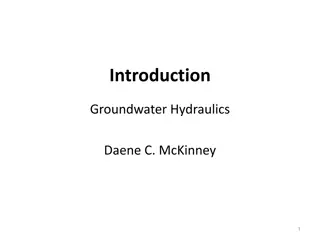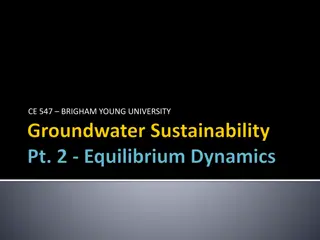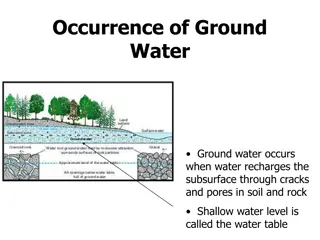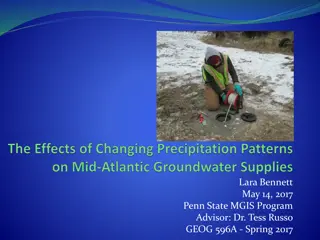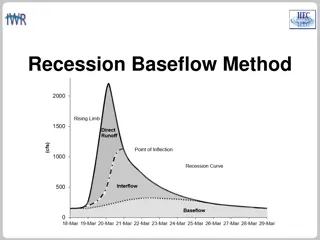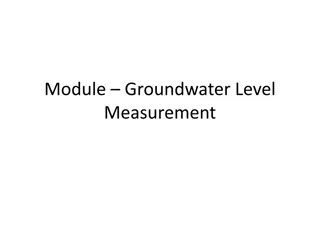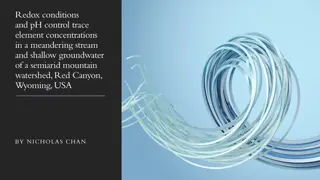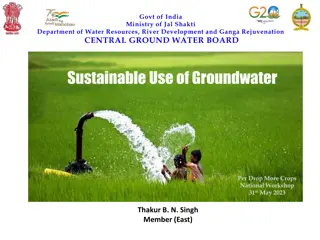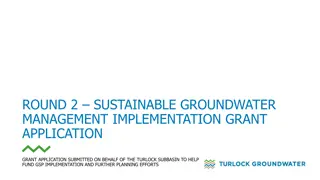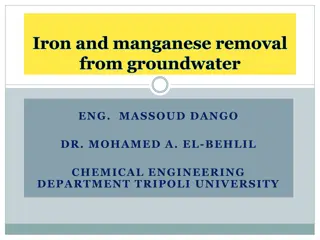Understanding Groundwater Hydrology Concepts at Brigham Young University
Explore the derivation of transient terms, specific storage mechanisms, and distinctions between specific storage, storativity, and specific yield in groundwater hydrology. Delve into the mathematical equations governing groundwater flow and storage, understanding the change in mass stored in the system and its relation to volume and head. Discover how specific storage relates to changes in water volume stored per unit change in head.
Download Presentation

Please find below an Image/Link to download the presentation.
The content on the website is provided AS IS for your information and personal use only. It may not be sold, licensed, or shared on other websites without obtaining consent from the author. Download presentation by click this link. If you encounter any issues during the download, it is possible that the publisher has removed the file from their server.
E N D
Presentation Transcript
Understand the derivation of the transient term of the governing equation Understand the physical mechanisms behind specific storage Understand the difference between specific storage, storativity, and specific yield
y z inflow - outflow = 0 ( v ) dz ( = ( v ) v ) - in dx x ( v x) x out x in x mass flow rate = v dy x dx 2 2 2 h 2 h 2 h 2 + + = k k k 0 x y z x y z
storage = + inf low outflow sources , sin ks t Assume that we have no sources and sinks. The term: storage t represents the change in mass stored in the system.
The mass per unit volume can be expressed as the density times the volume of the voids: m = Vv = (n Vtotal) = n dx dy dz The change in storage with respect to time can then be represented as: ( )dxdydz n t
In the steady state case: inflow - outflow = 0 or: ( ) ( ) ( ) v v v y = dxdydz dxdydz dxdydz 0 x z x y z
Now we have: inflow outflow = storage t or: dxdydz ? vy ? vx dxdydz ? vz dxdydz ?x ?y ?z =? n dxdydz ?t which reduces to: ? vy ? vx ? vz =? n ?x ?y ?z ?t
Once again, if is constant: v n v v y = x z x y z t Assuming kxy= kxz= kyz= 0 and inserting Darcy's law: 2 2 2 h 2 h 2 h 2 n + + = k k k x y z x y z t
Now we need to simplify n/t and write it in terms of head since the left hand side of the equation is expressed in terms of head. The term n/ t represents the change in volume due to a change in the head (n changes due to a change in head). The term can be related to head as follows: n h = S s t t where dV = = S Specific storage w s dh or the change in water volume stored in a unit volume of the aquifer per unit change in head.
1 Change in water volume stored in a unit volume of the aquifer per unit change in head. Specific Storage 1 1 1
Substituting: 2 2 2 h 2 h 2 h 2 h + + = k k k S x y z s x y z t This is sometimes called the "diffusion equation". Note that now we have an expression relating head (h) to position (x, y, z) and time (t).
If we have sources or sinks we can simply add one more term, R, which is intrinsically positive and represents inflow to the system. 2 2 2 h 2 h 2 h 2 h + + + = k k k R S x y z s x y z t or 2 2 2 h 2 h 2 h 2 h + + = k k k S R x y z s x y z t
An expression for specific storage can be derived as follows: A decrease in the head infers a decrease in the fluid pore pressure u and an increase in the effective stress in the soil ( ). The water that is released from the aquifer due to a decrease in h is due to: (1) Compression of the aquifer due to an increase in '. This is controlled by the aquifer compressibility, . dVw = - dVT = VT d '
for a unit volume of the aquifer, VT = 1, and dVw = d ' d ' = - du = - wdh substituting: dVw = - w dh for a unit change in head, dh = -1: dVw = w
(2) Expansion of the pore water due to a decrease in u. This is controlled by the fluid compressibility, : dVw = - Vw du since Vw = nVT, = n (for unit volume of aquifer) dVw = - n du Also, for a unit drop in head (dh = -1): du = w dh = - w thus: dVw = n w
Combining both terms gives us an expression for specific storage: Ss = w( + n ) Note: 1 = = E ' where: = strain E = Modulus of elasticity
decreases with increasing stiffness and typical values are given below (Freeze and Cherry): (m2 / N) Media Clay 10-6 - 10-8 Sand 10-7 - 10-9 Gravel 10-8 - 10-10 Jointed Rock 10-8 - 10-10 Sound Rock 10-9 - 10-11 is a constant for water equal to 4.4 X 10-10 m2/N


